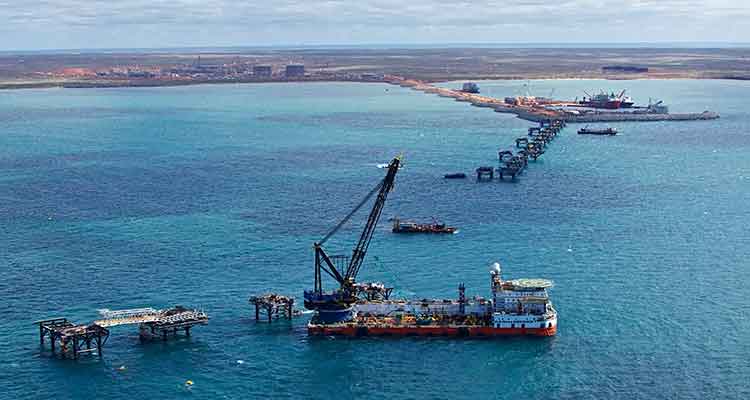
Kitimat LNG is in a “horse race” with an LNG project in Western Australia–and at this point, according to the Australian media–Kitimat is winning, even though the Australian Gorgon project is much further ahead while the Kitimat LNG project at Bish Cove hasn’t really started.
The Australian reports come from the same conference call Chevron held with financial analysts last week, when the company said the final investment decision for Kitimat LNG has been postponed to 2014.
The Brisbane Times is quoting Chevron as saying that expansion of the Gorgon “will be in direct competition with exports from North America, which have a cost advantage.”
Chevron has a 47.3 per cent stake in Gorgon. Shell which is developing its own project at Kitimat, LNG Canada, has a 25 per cent stake in Gorgon. ExxonMobil holds 25 per cent.
”In the case of Gorgon train four … we are happy to see both of them move forward,” Chevron vice-chairman George Kirkland told analysts late last week, referring to the competition with Kitimat. ”[There is] a bit of a horse race between them at this point.”
Shipping gas to north Asia from Canada is cheaper than exports from Australia, he said, although the challenge is to find markets for the gas. ”The development cost at Kitimat … may end up being less than in the case of Gorgon,” he said, which ”has the benefit of [being a] brownfield development on the plant side”.
”We’re going to offer volumes … and interest in the plant as a combination,” Mr Kirkland said of the Kitimat marketing plans. ”We think that’s a big advantage.
”Our goal is to maintain our … first-mover advantage … We have had some initial discussions with Asian buyers.”

According to Wikipedia, the Gorgon area of Western Australia is the site for a number of liquified natural gas projects. The projects are off shore and close to the export terminals, much different from British Columbia where the gas fields are in the Peace River district in the northeast of the province.
The Gorgon field is centered about 130 kilometres (81 mi) off the north-west coast of Western Australia, where the water depth is approximately 200 metres (660 ft). Other fields in the group lie to the north, such as Jansz-Io, which covers an area of 2,000 square kilometres (770 sq mi), in a water depth of 1,300 metres (4,300 ft).
It is one of the world’s largest natural gas projects and the largest single resource development in Australia’s history.
The Gorgon Project is developing the Gorgon and Jansz-Io gas fields, located within the Greater Gorgon area, between 130 and 220 kilometres off the northwest coast of Western Australia.
It includes the construction of a 15.6 million tonne per annum (MTPA) liquefied natural gas (LNG) plant on Barrow Island and a domestic gas plant with the capacity to supply 300 terajoules of gas per day to Western Australia.
Gorgon LNG will be off loaded via a 2.1 kilometre long loading jetty for transport to international markets. The domestic gas will be piped to the Western Australian mainland.
The Gorgon joint venture is investing approximately $2 billion in the design and construction of the world’s largest commercial-scale CO2 injection facility to reduce the project’s overall greenhouse gas emissions by between 3.4 and 4.1 million tonnes per year. The Australian Government has committed $60 million to the Gorgon Carbon Dioxide Injection Project as part of the Low Emissions Technology Demonstration Fund.

In May, Reuters reported that the $52 billion Gorgon liquefied natural gas (LNG) development was 60 per cent complete. At the time, Reuters said Chevron planned to start engineering and design work for an expansion by the end of the year.
Parts of the Gorgon project are in an environmentally sensitive area, Barrow Island, which has been a nature reserve in Australia since 1910.
Wikipedia says
Barrow Island’s ecology. The island is a Class A nature reserve, and home to theflatback turtle (classified as a vulnerable species) and numerous other animals not found on the Australian mainland. Other concerns are related to the adequacy of quarantine procedures on Barrow Island to protect against the introduction of non-endemic species, and risks associated with geological sequestration of CO2.It was reported in November 2011 that native animals on Barrow Island had been accidentally killed daily with a known total of 1550 since construction began.
Chevron says
The Gorgon Project is being undertaken in accordance with strict environmental standards to preserve the island’s ecology.
Central to the Gorgon Project’s commitment to protect the conservation values of Barrow Island is the Quarantine Management System (QMS), which directs
the Project’s quarantine operations. The QMS is the largest non-government quarantine initiative in the world and was considered to be “likely world’s best practice” by the Western Australian Environmental Protection Authority. The Project’s gas processing facilities are being constructed within a 300 hectare ground disturbance limit, which represents 1.3 percent of Barrow Island’s uncleared land area.
Gorgon Project Overview Chevron document pdf